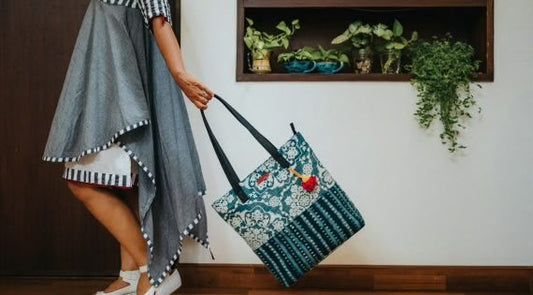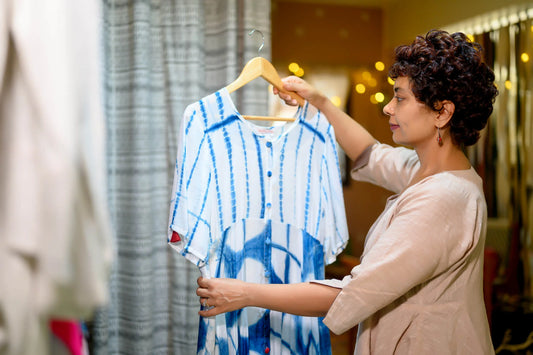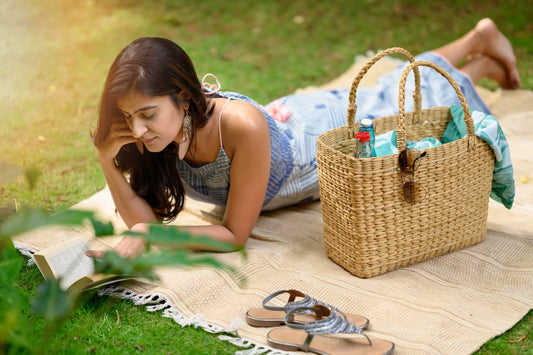We hear the term “Sustainable Fashion” quite frequently these days. In fact, it’s very encouraging to see that a lot of people are supporting and favoring sustainable fashion. But let’s understand in-depth, exactly what this term means and what makes sustainable fashion brands so special. Do we really understand exactly what it means?
In this blog “Sustainable Fashion – How to Make It A Way of Life” I am going to explain what is sustainable fashion, how to identify a sustainable fashion brand, and simple steps to make sustainable fashion a way of our life.
What is Sustainable Fashion?
Sustainable fashion in simple words means environment-friendly products, but with higher ecological integrity. Sustainable fashion and ethical fashion is an approaches to sourcing, manufacturing, and designing clothes to provide the maximum benefits to the industry and society at large. Also, it ensures minimizing the harmful impacts on the environment at the same time.
On one side, the fashion industry contributes to a major share in annual revenues and is one of the most resource-intensive industries in the world. On the other side, this industry also happens to stand as one of the biggest pollutants in the world. Hence, switching to sustainability and adopting sustainable fashion is the need of the hour now.
Sustainable fashion is not only milder on the environment, it is also more ethical, which means that it is morally correct and acceptable. Since environmentalism goes hand in hand with socially equitable practices, thus, ethical and sustainable fashion are intricately tied together.
Ethics + Aesthetics = Sustainable Fashion
How To Identify A Sustainable Fashion Brand?

So have you wondered what makes sustainable fashion so special? Let’s find out below why sustainable fashion stands out from the rest of the others. Let’s understand what are the qualifying factors for a brand to become a sustainable fashion brand.
1. Softer on the Planet
Sustainable fashion practices are lighter on our mother nature. Natural fabrics such as cotton, linen, hemp, jute, silk are biodegradable hence they can compost easily into the soil. Whereas synthetic fabrics such as polyesters and nylons lead to huge landfills. Hence natural and organic fabrics have a low impact on nature and are environment friendly.
The fabrics for sustainable fashion brands are patiently crafted on hand looms which empowers the small weavers and their families and produces zero waste or pollution. Whereas to meet the huge volumes of the ever-changing seasonal fast fashion, the mass scale fabric is produced on power looms, resulting in higher consumption of natural resources such as power.
Also, huge factories producing high volumes in bulk quantities of fast fashion products, create pollution and wastage, continuously leaching out toxic chemicals and fumes. Whereas sustainable fashion brands ensure that they make maximum utilization of their resources and reduce the wastage to a minimum.
“As consumers, we have so much power to change the world by just being careful in what we buy”- Emma Watson
2. Provides value for money
There is a myth surrounded around sustainable fashion brands that they are often more expensive, as compared to fast fashion brands. I think if you look into it deeper, you will realize that in a long run it’s not expensive at all it lasts longer as compared to fast fashion. You will buy less, hence discard less.
Also, sustainable clothing is handmade and handcrafted with detailing, which is labor-oriented. It travels through a lot of hands by the time it gets converted into the final product, which makes it unique and special. Look at it that you are also supporting some weaver or artisan working hard somewhere in the interior of some village.
The best brands for Sustainable fashion focus on quality over quantity, making it more promising and true value for the money spent on it. The products are uniquely handcrafted with more focus on the finishing and detailing, thus making them more premium and long-lasting. On the other hand, the clothing produced by fast fashion brands is mostly not made to last longer. As their philosophy is based on short-term or passing trends. As a result, the consumer lands up buying again and again in a shorter span of time. Thus quality and long-term commitment to the product are not their priority.
3. Supports Fair Labour Practices
Sustainable fashion brands support fair labor practices and fair wages to all the employees working with them. All the fabrics used are responsibly created or directly sourced from the artisans at a fair rate set by them. The employees are well compensated above market standards and well looked after so that every piece is made with a lot of love, affection, and purity.
“It isn’t enough just looking for the quality in the products we buy, we must ensure that there is quality in the lives of the people who make them” -Orsola De Castro
Fast fashion, on the other hand, usually pays low salaries to their workers and provides poor working conditions to the staff, hence exploiting them in order to have a low-cost product.
So by switching to ethically made brands you are making a conscious choice that the clothing in which you have invested your money hasn’t taken undue advantage of workers or used child labor.
“There is no beauty in the finest cloth if it makes hunger and unhappiness” – Mahatma Gandhi
4. Ensures the best usage of waste
Starting from the basic fiber stage to right till the final end product, there is excessive waste in the fashion industry. Having worked in the export-import sector for over a decade n a half, prior to starting my label- AMAR KOSA, I’ve experienced and observed the amount of material wastage that gets accumulated with every change of season. There are several sustainable fashion brands that utilize this recycled or deadstock fabric or material and convert it into a limited edition collection. Even at AMAR KOSA, we follow this practice.
Now that we understand how to categorize a label as a truly sustainable brand, let’s also see how we can follow simple sustainable practices in our own lives.
Simple Practices To Make Sustainable Fashion A Way Of Life

1. Mindful purchasing
We often tend to buy just out of habit or an impulse. A purposeful and more mindful approach should be practiced as a way of living. One should not buy new clothes unless you really need them. Shopping should be a well-planned and well-thought-through decision and not done out of a compulsive habit. It is very important to make meaningful choices before you decide to buy new clothes.
“Buy less. Choose well. Make it last”- Vivienne Westwood
You may also refer to our blog “The conscious closet” for more understanding on this topic.
2. Back to the basics
One doesn’t really need to always run behind the ongoing trends blindly. We can very well stay tuned with fashion and trends in several other ways, with the help of a little smart thinking. By having some basic essential selected pieces in your wardrobe which can be smartly and aesthetically blended and mixed with other things from your belongings to give it a different new look. With these few classic possessions, you can play around to create multiple styles. For example, our asymmetric jacket when teamed up with the indigo shibori dress would make a perfect Sunday brunch dress or casual wear for a holiday. However, the same jacket when teamed with a pair of trousers with a basic solid tee inside will change its look totally. Similarly, now team this jacket with the indigo skirt to achieve an absolutely new look.
By smart mix and matching, we can create multiple new looks from one outfit which will contribute towards a sustainable way of living.
3. Story behind that dress
Have you ever thought about this simple question – who made your clothes? Imagine how much value and meaning you can add to your dress when you realize and understand the story behind that outfit.
How many people’s life has that outfit touched. Identify your nearby local brands and support and encourage them. Try to shop from local makers.
“Wear clothes that matter”- Solitaire Townsend
4. Out of the box thinking- recycle and upcycle
How many times have you discarded a good dress just because it does not fit you anymore or dumped a top because you don’t like it anymore or a newly packed saree sitting in your cupboard because you didn’t find the occasion to wear it. I’m sure this has happened to all of us. Before you want to throw away anything, just look at it once again with an open mind and see if you can re-cycle n turn it into something useful.
At AMAR KOSA we have helped a lot of our clients to re-use their old sarees. We can design and customize a dress from your old favorite saree, which you don’t want to wear anymore as a saree but also at the same time don’t wish to part away with it. We all have some priced possessions- something in our wardrobe that belongs to our mother or grandmother, but it’s not usable in the current form- we can help you by converting those into something more practical and usable product.
5. Make smart choices
Be selective and clear in your choices. Invest in fewer but good quality garments. Choose fabrics that are environment friendly eg- Cotton. Jute, Silk, Bamboo, Hemp, Flax- go for natural or organic fabrics. Check at the time of purchase what kind of dyes and chemicals have gone in your clothing. Look for naturally dyed fabrics, it is not only better for the environment, but also it is hypoallergenic and safe on your skin.
6. Shower love on your clothes
Handle your clothes a bit gently so that it stays longer with you. Follow and practice the wash care instructions mentioned on the label. Handloom clothing breeds on love. You can easily wash them at home. Also, you do not need to spend on expensive dry-cleaning all the time. They are not high maintenance, you don’t have to keep sending it for dry cleaning unless specified. A simple mild detergent hand washes at home in cold water is good enough.
Also remember dry cleaning uses several harsh chemicals and detergents, which are not eco-friendly most of the time.
7. Pass it on
Last but not the least, if you no longer want something in your wardrobe and if it is in perfect wearable condition, then pass it on to a friend or relative. We should not hesitate in circulating the unused items among our close network of social circles. Finally, if nothing works then go ahead and donate it to a trust or a charitable organization.
Sustainable Fashion in Summary…
The approach of sustainable fashion is towards sourcing, manufacturing, and designing clothes which maximize the benefits to the industry and society at large. And at the same time minimizes the impacts on the environment. All the natural fabrics which we derive from our environment are sustainable. Cotton, jute, linen, hemp, flax, and silk are all sustainable fabrics. It does not have any chemicals, and it helps you to reduce your impact on the environment.
Sustainable fashion brands are a great asset to the fashion industry. As they are helping in providing clothing that is kinder to the environment.
Hopefully this blog “Sustainable Fashion – How to Make It A Way of Life” could help in providing you some useful insight about sustainability.




